Care rules
The unpretentiousness of this plant is legendary. It is believed that it only needs to be planted and that's it - then this American emigrant with giant leaves will be able to stand up for herself.
Darmera is not sick, and she is not attacked by those who want to profit from large leaves. This usually does not happen in nature. There is no such organism that would not become a food source for another organism. Even thorny and poisonous plants have enemies.
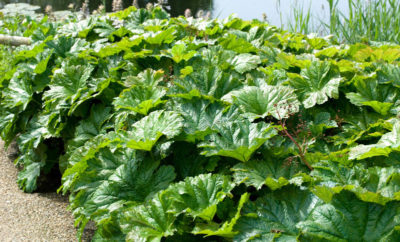
But Darmera doesn't have them. Perhaps this is due to the fact that their pests were not transported to Europe with this plant. At home, the plant loves places near water bodies, but with excessive moisture, the stems and leaves can be affected by mold and rot.
You need to make sure that Darmera is in her usual conditions all the time. In nature, she, of course, also has her own problems. For example, a change in the water level in a river or lake can lead to desiccation or, conversely, to waterlogging of the Darmera growing area. Then the plant dies.
In addition, in natural conditions in specific territories, the species composition always changes. This happens for two reasons: changing environmental conditions or increasing the competitiveness of other species.
It is necessary to regulate the level of shading of Darmera. Open to all winds and the scorching sun, it will lose its luxurious leaves - flowers and leaves will become smaller than their usual sizes. If Darmera, for some reason, is planted on an area where the scorching rays of the sun will illuminate it all the time, then even with regular watering, the flowers and new leaves will be smaller.
Light shading creates an increased humidity of the air, which allows flowers and leaves of this plant to be fully realized.
Weeding as an indispensable element of caring for any plant in this case is not burdensome. It may be necessary to remove weeds from the area where Darmera grows, perhaps only in the spring, when the huge thyroid leaves have not yet blossomed, and also in the first year of planting this plant. At other times, Darmera can fend for herself. The shadow under her leaves is so great that it darkens other plants.
Top dressing can be carried out occasionally, during a period when, due to drought, even such a plant needs to be watered.
Darmer in landscape design What to combine with
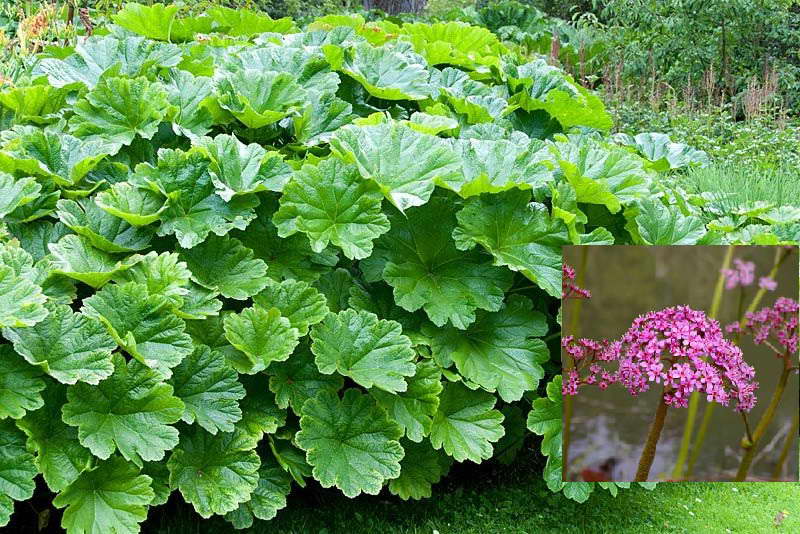
Darmer in landscape design photo in the garden
Darmera feels great surrounded by ferns, host, rogers. Looks great in splendid isolation against the backdrop of a lawn or near a pond. This exotic, rare, decoratively stable perennial with beautiful leaves grows successfully, develops, pleases flower growers for many years.
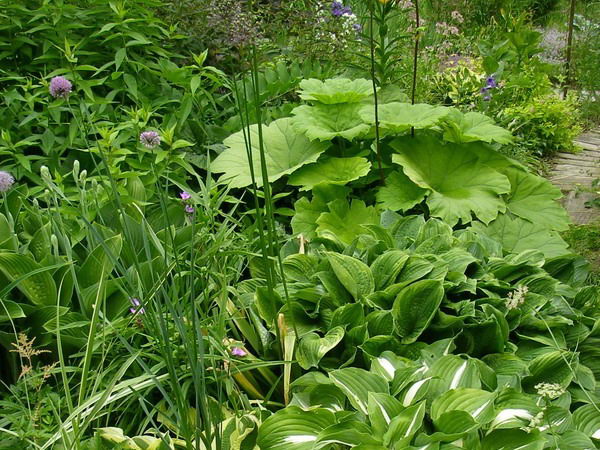
Darmer and the hosts in garden design photo
Spending a minimum of effort in caring for this curiosity, you will get a luxurious bush that delivers a lot of positive emotions when contemplating it.

Darmer in garden design photo
Darmera is also grown as a container plant that decorates gazebos, space under awnings, near houses, on terraces. Tall, powerful leaves sometimes look more exotic than palm trees.
How to propagate Darmera?
The most common way to reproduce a Darmera flower is by dividing the rhizome. It must be carried out in the spring before the leaves begin to grow, or in the fall. A segment with a bud is separated from the rhizome, kept in a fungicide solution for 1.5-2 hours, which will protect it from rot, and then planted in a new place. Darmer multiplied in this way will become decoratively attractive as early as next year.
Darmeru can also be propagated by seeds.In this case, sowing is best done before winter, and if the procedure is planned in spring, then the seeds should be stratified by placing them in a cool, humid place (the optimum temperature is + 4-6 ° C) for 3-4 weeks. However, it must be borne in mind that seedlings grow very slowly and flowering will not come soon. The plant will reach decorativeness only in the 2-3rd year.
Planting acidantera in open ground
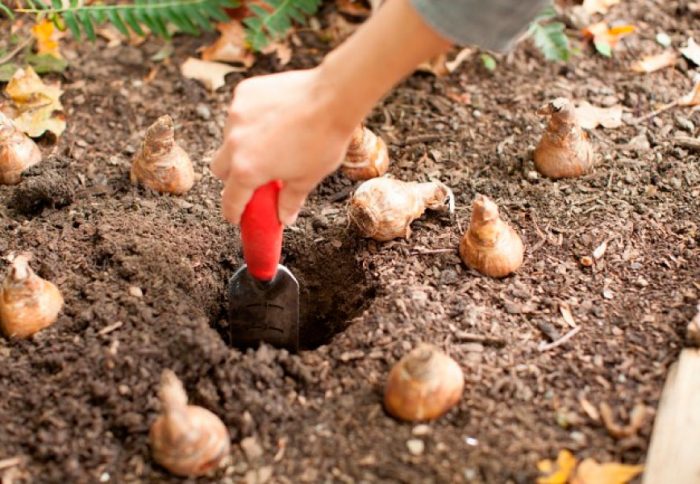
What time to plant
Since the tropical plant acidantera is thermophilic, it is planted in deep spring (from the last days of April to the end of May), after the soil warms up. A well-lit area is chosen for planting. If it is grown in a region with a long and relatively cold spring, then in order for the acidantera to bloom in a timely manner, its corms need to be planted for distillation in May. Take a pot that reaches across 12 to 15 centimeters, it must be filled with a permeable loose soil mixture. 3–6 onions are planted in it to a depth of 40 to 50 mm. Then the pot is removed on a well-lit windowsill or in a greenhouse. In the last days of May, flowers should be planted in open soil. From such grown corms, powerful bushes are obtained, which are distinguished by lush and long flowering.
Landing rules
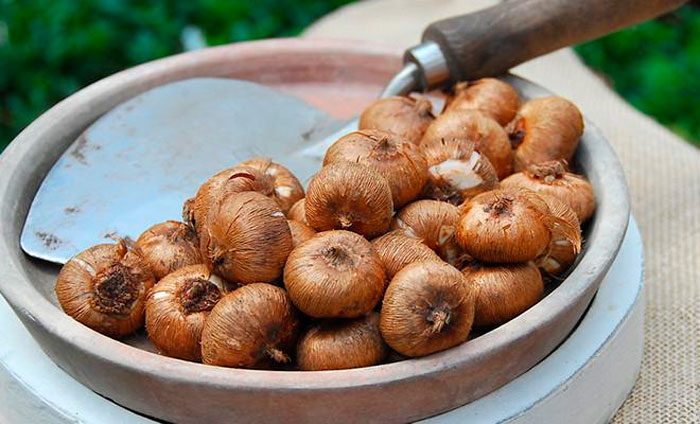
In mid-latitudes, as well as in regions with a warm climate, acidanters are planted directly into open soil. A site with a nutritious weakly acidic soil must be pre-prepared, for this it is dug up, applying fertilizers (humus or compost), as well as sand for drainage, if necessary. Then the surface of the site must be leveled.
Before planting, corms must be treated with a weak solution of potassium manganese, when they dry out, they should be planted on the site. The onions are planted in groups of 8–30 pieces, they are buried in the soil by 8–10 centimeters (depending on the size of the planting material), while a distance of 1–20 centimeters should be kept between them. The planted bulbs need abundant watering.
Darmera care
* Watering. Since Darmera is a moisture-loving flower, it must be watered often, but in moderation, since severe waterlogging of the soil can lead to root rot.
* Top dressing. Darmera responds positively to organic and mineral fertilizers. If the plant is fed with liquid mineral fertilizers, then in this case it is necessary to water it once a month. Dry fertilizers are best applied to the soil in early spring before flowering.
If dry organic fertilizers are used, then they should be applied under the bush during the growing season. As organic matter, you can use well-rotted dry manure, chicken droppings or leaf humus. With the onset of autumn, feeding should be stopped.
* Preparing for winter. Darmera is not adapted to severe frosts, therefore, before the onset of frosts, it is necessary to take care of its protection from the cold. The plantation must be covered with fallen leaves, straw or sawdust. If the snow cover is not high, but the temperature is low, then you can additionally cover the Darmera with snow.
* Diseases. The rhizome of the plant can be affected by rot. In this regard, it is necessary to monitor the degree of soil moisture. As a preventive measure, it is recommended to treat Darmer with a fungicide solution in the spring.
What is this plant?
We recommend that you familiarize yourself
Darmera thyroid is a plant that grows only in the United States of America, or rather, in two states: Oregon and California.
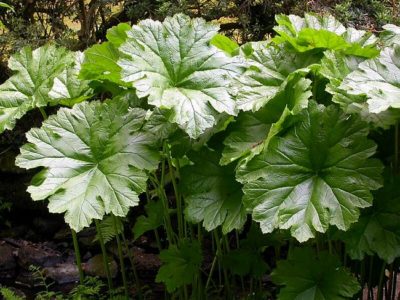
This plant was originally described by the American John Tory and the Englishman George Bentham. As a result, the species was named thyroid saxifrage. Then, as scientific disputes were resolved, these same scientists separated this species into a separate genus and gave it the name thyroid peltiphyllum.
In parallel, another scientist, A. Kellogg, worked on the study of this plant. He named the species Darmera peltata. So this plant is lucky - it has several names, and they are all correct. However, this causes some confusion among practitioners who simply want to breed a plant with certain properties. However, the name of Darmer is for some reason more popular, although the designation Peltiphyllum thyroid is not so rare.
This plant can be described as follows:
- 1 The root system is pivotal. After a few years of growth, Darmera develops a massive rhizome, which produces additional roots.
- 2 Leaves simple, rounded, palmate-lobed. The leaf blade is very large - almost 1 m in diameter. The leaf really resembles a battle shield. The petioles of such leaves are thin, but very strong and long, up to one and a half meters in length.
- 3 Flowers are small, bisexual, five-membered. The flower petals are almost white, with a slightly pinkish tint. However, the umbellate inflorescences appear pink due to the deep pink heart of the flower.
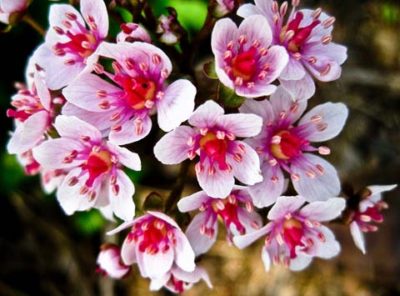
A distinctive decorative feature of this plant is its early flowering. The pink inflorescences on high legs grow to the appearance of their giant leaves. The flowering shoots of Darmer reach a height of one and a half meters.
Landing rules
In the wild, Darmera grows along the banks of streams and rivers. She loves high humidity and loose fertile soil. Therefore, it should be planted in well-ventilated areas with high humidity. The ideal option would be to plant peltiphyllum in the open field on the shore of a pond. Darmer prefers shade or partial shade to brightly lit areas. It will not die under the scorching sunlight, but it will lose its decorative appearance: the color of its leaves will fade, and the leaf plate itself will dry out at the edges.
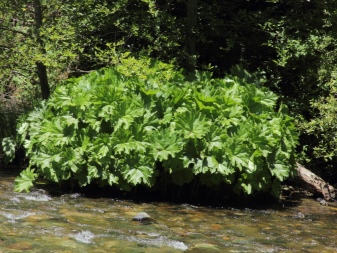
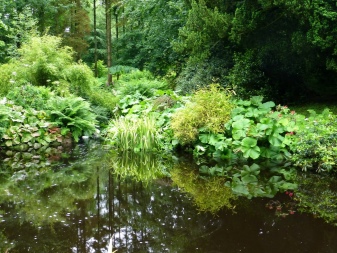
When choosing a site, you should start from the size of the plant. Since the huge leaves of peltiphyllum take up a lot of space, the space should be planned so that there is nothing within a radius of 1.5-2 meters from it. If you plan to make a flower arrangement, you should use Darmera as a tapeworm (this is the name for single ornamental plants with high stems that adorn open areas of the garden).
Despite the exactingness of planting conditions, Darmera is unpretentious to the composition of the soil. It can be grown on any piece of land. But the best option for planting is considered to be slightly acidic or neutral fertile soil. The soil should be regularly moistened, and after watering it should be loosened. Dry darmere is contraindicated, and without air, its roots suffocate even in moist soil.
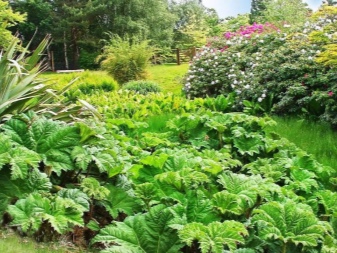

Experienced gardeners recommend preparing a soil mixture of two parts of garden loam, one part river sand and one part peat... Add 70-80 g of universal fertilizer to the mixture. All components are mixed and applied to the site right before planting darmers in open ground.
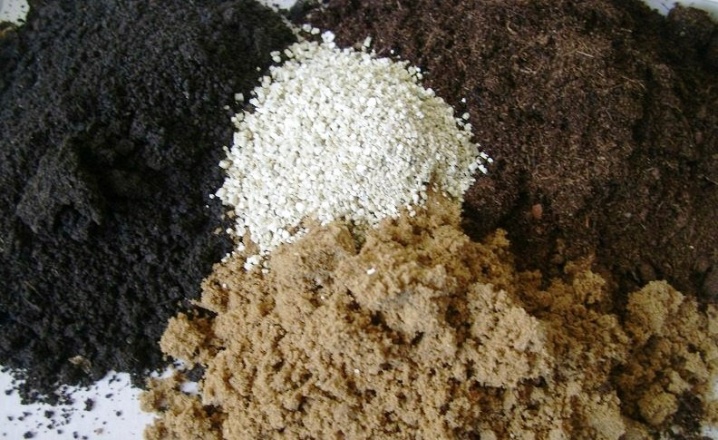
Growing Darmer in the garden

How to plant a photo darmer
Delicate darmer leaves do not tolerate sunlight well - the most suitable place for it would be under the crown of a large tree, near buildings and fences that partially block it from the sun's rays, and it, in turn, serves as a screen for unsightly areas. Darmera can live in a sunny place, losing a little its attractiveness.
Landing
When planting, the size of the plant should be taken into account - thanks to the huge leaves of the darmer it takes up a lot of space, leave it more space, about a meter or two in diameter. It is best used as a tapeworm.
Watering and soil
It is undemanding to the quality of the soil, but it grows and develops much faster on loose, fertile, moisture-containing soils. Darmera feels good on the coast of ponds and artificial reservoirs.
Water the flower regularly, abundantly moisturizing the ground.She loves the humid atmosphere around her - you can place the plant near a pond or a container with water for irrigation. If the ends of the Darmer's leaf plates dry out, which often happens in an open, sunny place, often irrigate the plant with a watering can or place a container of water near it.
Top dressing
They are fed once a month with liquid complex fertilizer or mullein infusion. Dry manure can be used as fertilizer by mulching the soil around the flowers. If a lot of organic matter was introduced during planting, feeding can be omitted. It will be enough in the spring to spray adult specimens with ammonia water to build up green mass. For this, 2 tablespoons of ammonia are stirred in 10 liters of water - this solution is poured directly from the watering can.
Preparing for winter
The flower requires shelter for the winter. For this, dry straw, sawdust, fallen leaves are suitable. If the snow cover is low, you can additionally pour a snowdrift on top.
Often, peduncles are damaged by late return frosts, so that this does not happen, it is worth organizing a light shelter from non-woven material.
Darmera is practically not susceptible to diseases and attacks of pests. Use soapy water from time to time for prophylaxis.
Description of thyroid darmers
Darmera is a herbaceous perennial belonging to the Kamnelomkovy family. At first this plant was called Saxifraga peltata, but after the American botanists D. Bentham and D. Tory recognized it as a separate genus, it became known as Peltiphyllum peltatum.
The Greek word "Peltiphyllum" has two parts:
- pelte - shield;
- phyllon - sheet.
After an additional description made by A. Foss, the flower was named Darmera peltata (Darmera Thyroid). In the past, it grew in the forests of America, later it was cultivated and transported to Europe, and then came to Russia.
Darmera-Peltifillum has an original structure, which is significantly different from other landscape plants.
Perennial has the following botanical features:
- The diameter of the leaves is from 75 to 100 cm. The leaf plates are funnel-shaped, tapering at the base and have notches along the edges. Along the perimeter, their shape resembles a shield. Depending on the season, the leaves are characterized by a change in color: in summer they have a greenish color, and in autumn they are red-crimson.
- The diameter of the root system is from 4 to 6 cm, it has a knotty rod structure. Over time, the plant forms a massive rhizome, on which a large number of additional roots are formed.
- The length of the peduncles is up to 70 cm. Outwardly, they are dark brown stems with a light pile. These parts of the plant grow in April before new leaves appear.
- The diameter of the flowers is 10-12 cm. The small-sized flowers are similar to fluffy balls due to their dense growth at the tops of the peduncles. During the flowering period, Darmera is covered with pink flowers of various shades. The duration of flowering is 2-3 weeks: at the beginning of summer, the seeds of a perennial are already ripening.
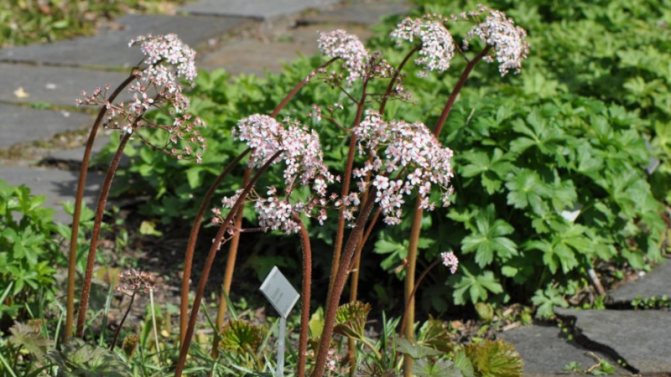
Methods of reproduction of thyroid darmers
In order for beautiful pinkish flowers to appear on the site, you can use two methods of flower propagation.
One of the methods of "reproduction" of the thyroid darmer is generative. In this case, growing from seeds is carried out. Planting material can be purchased at any specialized store. But this method is not very convenient, since it will take a long time to wait for a fully flowering bush.
Using a vegetative method would be more appropriate. Here the division of the plant occurs through the root. This is a simpler and more effective method of reproduction of thyroid darmers. Planting material is extracted from the ground, which is divided into several parts, and then dug into the ground in various parts of the garden.
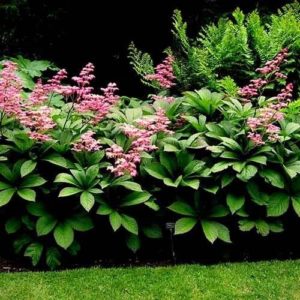
Darmeru is successfully propagated by dividing the bush
In order to guarantee a new plant, the root is treated with a fungicide. Then parts of the planting material are distributed in containers with soil. If this procedure is carried out in the spring, then by the fall it will be possible to obtain high-quality seedlings. They are moved to prepared areas, fertilized with special fertilizing. If the whole procedure is carried out correctly, then the first flowering of the thyroid darmer can be seen as early as next spring. But this only applies to those cases when roots were chosen for reproduction.
With seeds, everything will take much longer. The first flowers on the bushes will appear no earlier than 2 years after the planting material is planted in the ground.
How to choose the right place in your garden?
The choice of a site in which the thyroid darmer will feel as comfortable as possible should be based on the natural habitat of the shrub. This delicate flower is native to the west coast of the United States, in the highlands of California and Oregon. Most often, peltiphyllum is found on the banks of clean water bodies, rivers and lakes. For this reason, it is considered an ideal plant for decorating a pond in a garden.
If there is no open source of water on the site, the peltiphyllum will need regular abundant watering.
It is important that there is no stagnation of water, otherwise the root of the plant will quickly rot. Therefore, the place on which the peltiphyllum will be planted must be well ventilated and ensure sufficient drainage of irrigation water.
In addition to the large amount of moisture, the successful growth of the shrub depends on sunlight. Darmera thyroid can grow in the shade and in direct sunlight, but in the latter case, strong lighting leads to the fact that the leaves and flowers grow smaller.
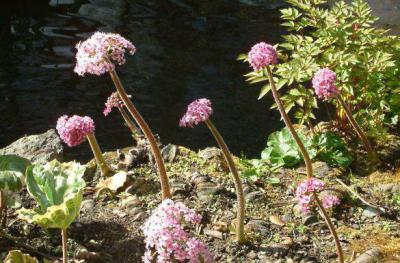
Peltiphyllum needs a lot of sunlight only in the spring, when the inflorescences are forming, therefore, a good neighborhood for darmer will be the proximity of broad-leaved shrubs or trees, the leaves of which will be protected from the sun only in summer. In addition to shrubs and trees, peltiphyllum feels good in tandem with shade-loving perennial plants such as hosta, rogersia, anemone and others.
Reproduction methods
The plant will take root well and will delight with lush foliage for a long time, if you use two main methods to propagate it:
- Seed method.
- Division of the bush.
Both are different from each other, but the result is excellent - after a while the peltiphyllum will delight you with its extraordinary leaves and beautiful flowering. Let's take a closer look.
Seed method
The most difficult and is used mainly for selection. But still, if you decide to try, then one hundred percent result is not guaranteed. In the case of a successful planting, the flowering of the bush can be seen only after a few years, because seed reproduction is a long process.
- Seed material should be determined for a month before planting in a dark, cool place where the air temperature does not exceed +5 degrees. The air humidity should be high.
- After the seeds have gone through the stratification process (cold hardening before planting), the seed is planted in a pre-prepared container. The soil is recommended light, loose, well fertilized and moisturized.
- When the first shoots appear, and this will not happen so quickly, then young shoots are transplanted into open ground, to a permanent place.
- Before planting, the land needs to be prepared a little: clear of weeds, loosen and feed well. Even in the most favorable conditions, you will be able to see a full-fledged flowering bush only after 3-4 years.
This method is complicated by the fact that throughout the entire process it is necessary to constantly maintain the required humidity of both air and soil. Only under this condition is a positive result guaranteed.

Dividing the bush
This method is much simpler and more popular, therefore experienced florists advise using it. Here's a step-by-step guide:
- In spring or autumn, the selected root of an adult plant (at least 4 - 5 years old) is divided into several parts. Each must have dormant buds in the amount of 2 - 3 pieces.
- The separated parts of the root system are required to be dipped in a solution with a fungicide for 2 hours before planting. This will protect the plant from fungal infections.
- Some growers additionally dip the roots in a clay mash.
- In a pre-prepared planting pit, a layer of manure should be put on the bottom, on which organic fertilizer is applied in the form of foliage, straw or sawdust.
- The roots should be planted in the next layer, consisting of garden soil and humus. Water well last.
It is better to plant a young darmer in the shade of mature spreading trees or bushes; in the first year of life, she does not need direct sunlight. So the plant adapts better and grows faster.
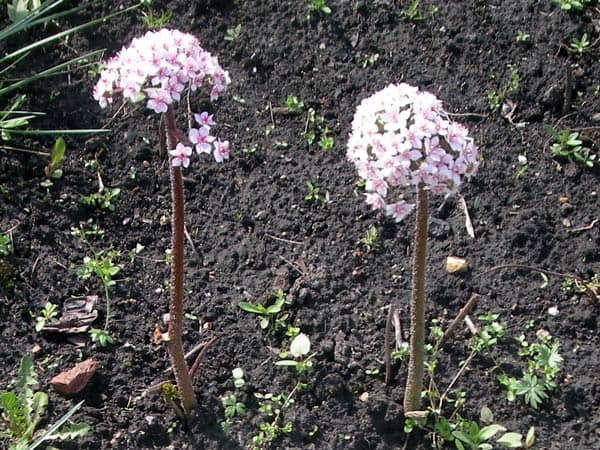
Seat selection
Despite the fact that darmera is an unpretentious and not capricious plant, in order to plant and properly grow it in your garden, it is necessary to take into account a number of some factors necessary for this. Let's start with preparation.
Lighting
Lighting at the planting site of peltiphyllum should be well darkened, since its delicate moisture-loving leaves do not tolerate the sun at all, from bright rays the wild plant completely loses its "presentable" appearance, the leaves noticeably fade, and at the edges they become dark brown from drying.
Astilba, aconite, brunner, dicenter, doronicum, volzhanka, saxifrage, swimsuit, lily of the valley, lupine, rogersia, cyanosis, hosta have been growing in the shade for years and feel great.
The soil
But Darmer is very indifferent to various types of soils, it can grow in completely different soils for many years without getting sick or suffering. However, the best option for a characteristic flower will be loose, fertile and moisture-containing places (6-7 pH), where it grows much faster and blooms more beautifully. Recommended and proven composition over the years:
- garden loamy soil;
- peat;
- compost;
- cleaned sand;
- 80 g of any fertilizer.
All prepared ingredients, except fertilizer, should be mixed in a 2: 1: 1: 1 ratio.
Diseases and pests
In early spring and until mid-November, prevention of fungal diseases should be carried out. For this, the Darmer is treated with special antibacterial agents. Periodically, the plant should be inspected for damage by fusarium, septoria, bacterial or heart-shaped rot. They arise as a result of improper care or lack of preventive measures.
At an early stage, any disease can be dealt with with folk remedies. As a rule, they use sharp-smelling tinctures and decoctions like ammonia, garlic or tomato tops. Potassium permanganate and formalin are used with the same success. If the early stages of the disease have already been missed, the plant can be saved with the help of chemicals. The neglected stages are no longer treated: the plant is removed from the flower bed and burned, and healthy bushes are treated with chemicals.
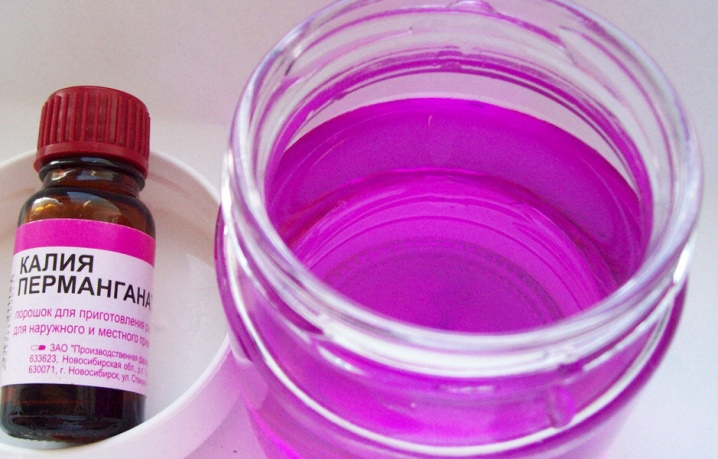
general characteristics
Darmera thyroid or, as this flower is also called, thyroid peltiphyllum is becoming more and more famous among flower growers, thanks to its decorative leaves and spectacular high peduncles, as well as the ability to modify the color of the leaves in different periods of the year.
- Darmera is a herbaceous perennial, belongs to the Saxifrage family. The homeland of this plant is considered the forests of America, where many popular flowers and shrubs originated, which were subsequently domesticated and took a firm place in our gardens and flower beds.
- This plant is actively used in landscape design. In a single copy, the flower looks just fabulous thanks to the huge leaves and delicate flowering.
- Darmer's leaf plates are very large, can reach a diameter of 70 cm to one meter. They have a rounded funnel shape, the edges are serrated along the entire perimeter. The name of the flower is translated from Greek as "leaf - shield". Indeed, especially in autumn, huge sheets of warm colors look great against the background of other garden flowers.
- The root system is pivotal and knotty in shape, with a diameter of 4 cm to 6 cm. During active growth, it develops root shoots, with which Darmera can be propagated. It has dark greenish buds. Sometimes part of the knotty rhizome emerges from under the soil layer.
- Peduncles stretch high above the leaves (length reaches 70 cm) and have a bare stem of a dark brown shade, slightly pubescent with white villi. The peculiarity is that the peduncle in early spring, in April, grows earlier than the young leaves bloom.
- The flowers are small, at the top of the peduncles they gather in panicles, resembling fluffy balls. The color scheme changes from bright pink to delicate pinkish white tones. The diameter of the flower is about 12 cm. The plant does not bloom for long: 2 - 3 weeks, and in June the seeds sometimes ripen.
- In flower gardens and gardens, you can also find a low-growing species of thyroid peltiphyllum, whose height is only about 40 cm. You can also find a bush with white flowering.

Given the changes in the color of the leaves, you should skillfully use this feature of the plant in landscape design. Darmer also looks very impressive against the background of blue water, if you plant it near an artificial reservoir.
Darmera thyroid: description, cultivation, care
About thyroid peltiphyllum, or darmer, in our country they learned relatively recently. The overseas plant was immediately appreciated by landscape designers, since the thyroid darmera is distinguished by its unpretentiousness, it tolerates winter frosts well. In addition, peltiphyllum is not only a flowering plant, but also an ornamental deciduous plant. What is the thyroid darmera (photos of leaves and flowers are presented below in the article)? How to properly grow this unusual plant on your site?
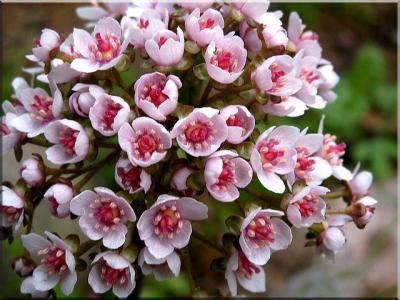
The peculiarity of peltiphyllum is that its appearance changes noticeably during the spring and summer. The flower appears first: the thyroid darmera blooms quite early, around the end of April or the beginning of May. On high peduncles of a red-brown hue, lush spherical inflorescences, consisting of small pinkish flowers, bloom. Plants during this period reach a height of 50 cm to a meter. At the same time, the leaves are practically invisible - they grow after the thyroid darmer begins to fade.
The leaves of the plant are rounded, with large finger-like veins; under favorable conditions, they grow into tall, lush shrubs. In this case, the diameter of each leaf can reach from 50 to 90 cm.The exception is the miniature variety Nanum, the leaves of which do not grow more than 45 cm.
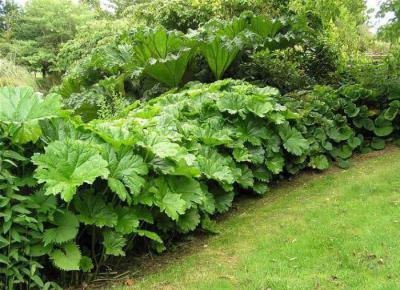
The color of "summer" peltiphyllum is rich green in shaded areas or pale green if darmera grows in the open sun. In autumn, the leaves of the shrub change color, acquiring a red-crimson hue interspersed with yellow or orange. In this form, the thyroid darmer decorates the garden area until the first frost.


